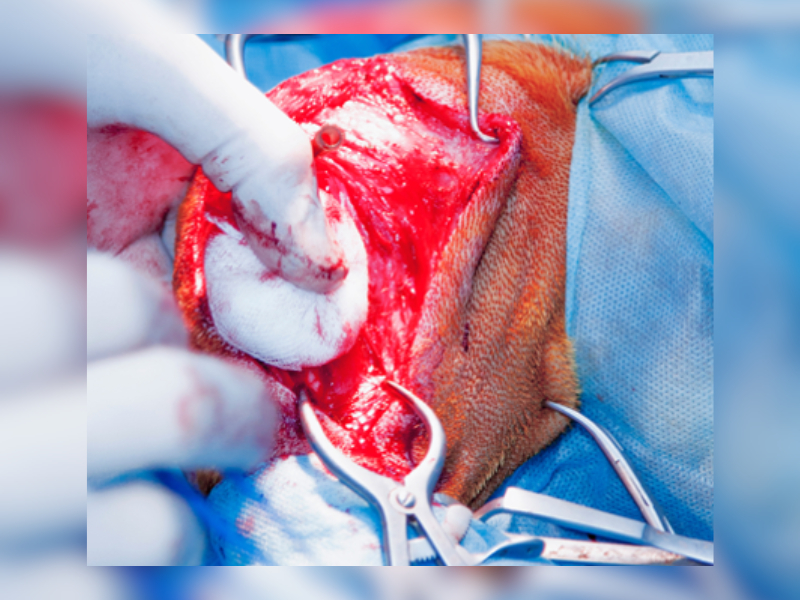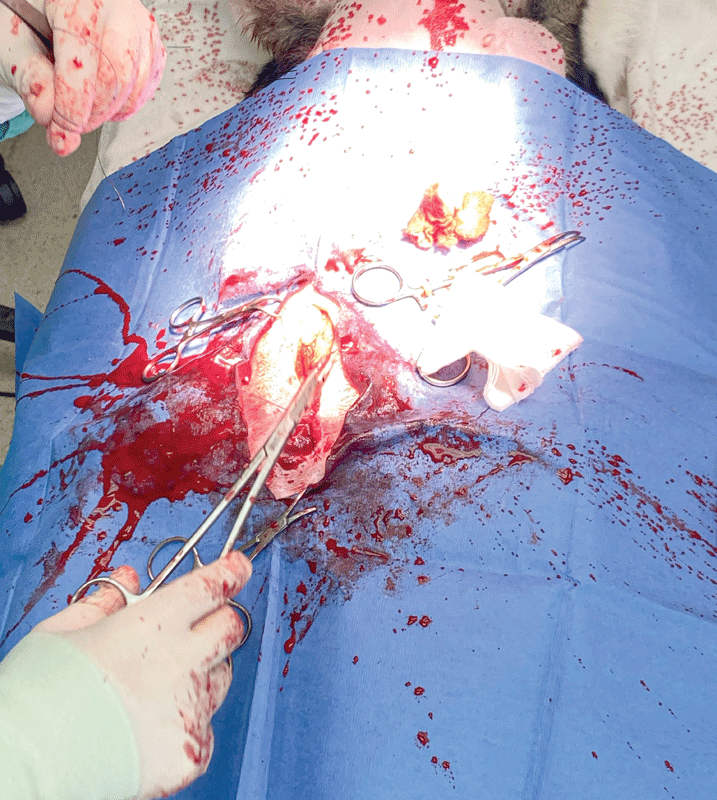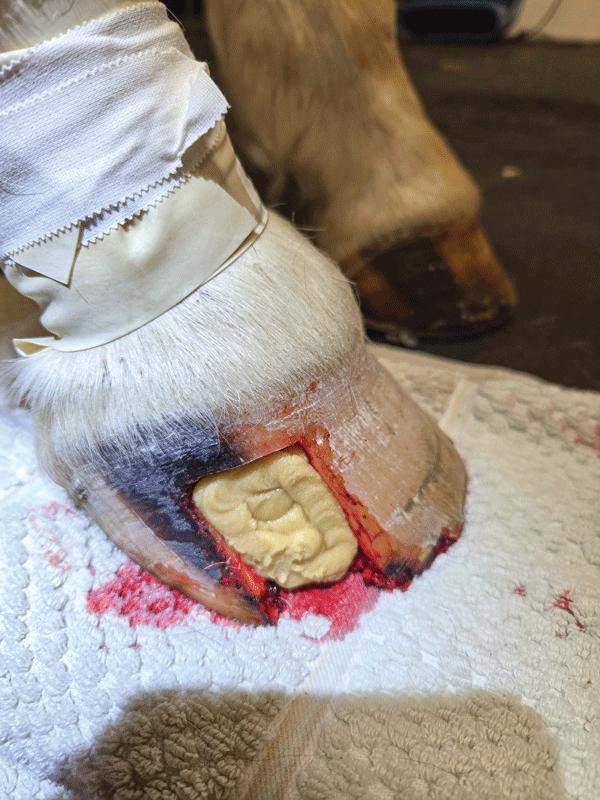
Hemostasis, the stopping of bleeding, has been a vital element in treating trauma or during surgery, for millennia. As well as direct pressure, ligation, and electrocautery, there are several hemostatic products available on the veterinary market. Yet, recent market research found only around 17 percent of veterinarians routinely used them for moderate bleeding.1 As they can act quickly to stop or control hemorrhage, and do not have a direct pharmacological effect on the patient, it is interesting the use of hemostatic products is so limited.
Blood loss has a detrimental effect on patients, especially compromised or small animals. Time spent controlling hemorrhage also prolongs anesthesia, with negative implications in terms of both patient outcome and cost.
Types of hemostatic products
Hemostatic products can be classified in a number of ways, but in simple terms, there are two broad classes: mechanical hemostats, which do not contain any active biological compounds; and active hemostats, usually containing thrombin. None of the latter are marketed for veterinary use.
There has been a gradual evolution in mechanical hemostats available over the last 100 years, and several are now marketed directly for veterinary use. Mechanical hemostats can be subdivided into those stopping or slowing down bleeding by being the basis for a clot, and the gel type that creates a seal and the clot forms underneath. The latter is more rapid in causing hemostasis, and some are in research and development, primarily for human use.2 One is available for veterinary use.
A brief history
It is worth a short historical review of hemostasis in human medicine and the methods that have been used. In Greek and Roman times, hemostatic products were mostly styptics, such as antimony, lead, and copper sulfates. Galen, who was a second century AD physician, surgeon, and philosopher, differentiated between hemostatic methods for venous and arterial bleeds.3 If twisting with a hook did not stop bleeding, then powders were recommended for veins (such as flour or gypsum). For arterial bleeds that did not stop with manual pressure, Galen used Celtic linen, presumably from Scotland. It is not so many years since linen thread was still used to ligate pedicles during spays by some veterinarians.
Although chromic catgut was used extensively from the late 19th century, there is evidence it and other animal derived ligatures had also been in use for millennia.3
Amputations require hemostasis, and during the Middle Ages this was mostly achieved using hot irons to cauterize bleeding vessels, rather than ligation.3 Although it is much subtler and focused than hot irons, around 30 percent of veterinarians in recent market research used electrocautery for moderate bleeding.1

Current use
In informal discussions with other veterinarians, the 17 percent figure routinely using hemostatic products found in the market research sounds broadly correct. Many rely on direct pressure (except where ligation would be appropriate). This is both time-consuming and often leads to significant blood loss. Some do use hemostatic products, usually based on collagen, gelatin, or cellulose. These, or similar products, have been around for decades, and are commonly found in veterinary hospitals.
If hemostasis is so important, why are hemostatic products not more widely used? Some veterinarians may see bleeding as an inevitable sequalae to some types of procedures, such as dental extractions, enucleations, amputations, and some mass removals. Others may find the preparation of some hemostatic products time-consuming, such as cutting out the correct sized piece. There is also potential for products, such as powders, to be detrimental to the proper visualization of a surgical area, and many products can take minutes to work, so only giving a perceived marginal benefit over direct pressure. Additionally, there is the concern that the hemostatic product becomes dislodged and the bleeding will then restart.

There are many surgical situations where ligation is inappropriate or unfeasible, such as dental extractions, or when there are many small vessels. In the latter situation, electrocautery may be appropriate, but there can be side effects, such as burning and tissue necrosis. Therefore, the use of hemostatic products should be considered.
The market research1 showing only 17 percent of veterinarians routinely using hemostatic products for moderate bleeding, also shows the number only went up to 25 percent for severe bleeds. This means, in some procedures, veterinarians may be risking unnecessary significant blood loss.
Some species have very small blood volumes; rabbits, for example, only have around 25 ml/lb, which means they can easily and rapidly become hypovolemic through hemorrhage.
Some veterinarians avoid using hemostatic products because they have had a bad experience previously, but this may well have been due to the characteristics of that hemostat, or less than optimum utilization of it.
Considerations
Given the multiple uses of hemostats for different procedures, it is important to review which types of these products are best for your practice, and the criteria for when you would use them. First, check for biocompatibility. While many of these products have been used for years without any pattern of significant issues, there is an international standard for human devices (hemostatic products are classed as devices), which is International Organization for Standardization or ISO 10933, and some veterinary hemostats may have been assessed against this standard. It is also important to ensure the product does not have an exothermic reaction when in contact with blood and tissue.
Another consideration is how quickly the hemostat will take effect, particularly with severe bleeding. Speed is dependent upon two factors: how quickly can the product be applied to the bleed, and once applied, how quickly it will stop the bleeding. Some products may require a degree of preparation, such as cutting to size, whereas others are instantly ready. Some may take several minutes to achieve hemostasis, whereas others deliver this in a few seconds. Those products that work by becoming part of the clot tend to be slower than those that create a mechanical seal. For high-pressure bleeds, applying some pressure may be required initially to keep the hemostat in place, but powders are at risk of becoming dislodged from the bleeding site.
Another factor is the degree of control the veterinarian has over the placement of the product. Can you easily get it to where the bleeding is, and can you limit where it goes? The latter is difficult with some powders, and the veterinarian may wish to place the hemostat in a specific place, rather than a more general application. Some hemostatic products allow very precise application. Ideally, it will conform to the wound/surgical site, thereby increasing the hemostatic efficacy.
Many products work by encouraging clot formation by being the matrix on which the clot forms. However, if there is a concern it may become dislodged, or the veterinarian wishes to progress after hemostasis (such as in some dental procedures), then the bleeding will restart.
Products, such as hydrogels, cause clots to form under the gel by creating a mechanical seal and can be safely removed after a few minutes without concern bleeding will restart.
Market research suggests there may be many lost opportunities to improve patient outcomes by low routine use of hemostatic products for moderate or severe bleeds.1 Veterinarians should review their use, and consider increasing their utilization, but it is important in selecting a veterinary hemostatic product that it has the right characteristics to maximize the likelihood of delivering maximum benefit in the clinical scenario it is being used.
Neil Smith, BVetMed, MSc, MDA, MA, FRCVS, is the scientific services veterinarian for VETIGEL, manufactured by Creslion, Inc., and has had a 30-year career in the British Army. Dr. Smith was the chief veterinary and remount officer for the U.K. Armed Forces for seven years and was the first chair of the NATO Military Working Dog Veterinary Expert Panel. He also served as exchange officer with the U.S. Army in the 1990s.
References
- Brakke Consulting, Veterinarian Survey Regarding Surgical Procedures, report prepared for Cresilon, Inc, 16 Jun 2023 (on file)
- Boxiang Zhang, Min Wang, Heng Tian, Hang Cai, Siyu Wu, Simin Jiao, Jie Zhao, Yan Li, Huidong Zhou, Wenlai Guo and Wenrui Qub, Functional hemostatic hydrogels: design based on procoagulant principles, J Mater. Chem. B, 2024, 12, 1706. DOI: 10.1039/d3tb01900d
- Harvey, The History of Hemostasis, Annals of Medical History, 1929, 1(2), p 127-154. https://www.ncbi.nlm.nih.gov/pmc/articles/PMC7945520/
